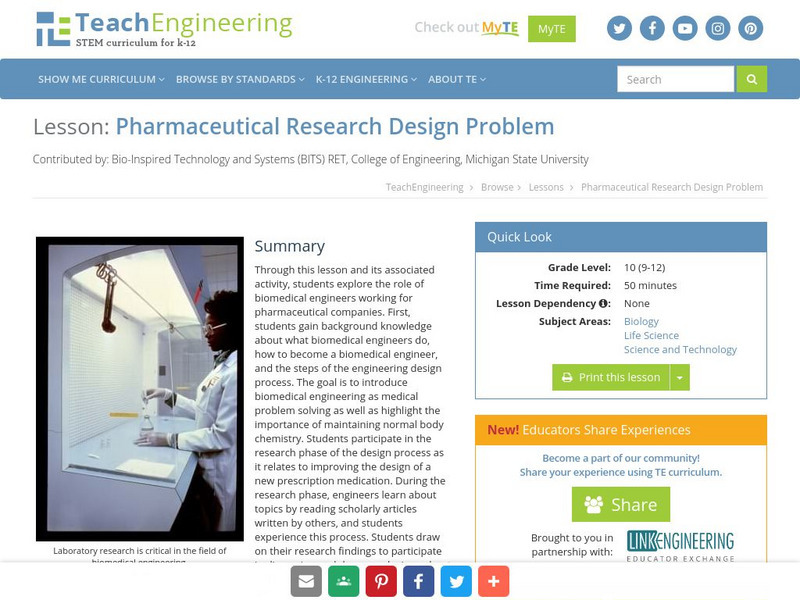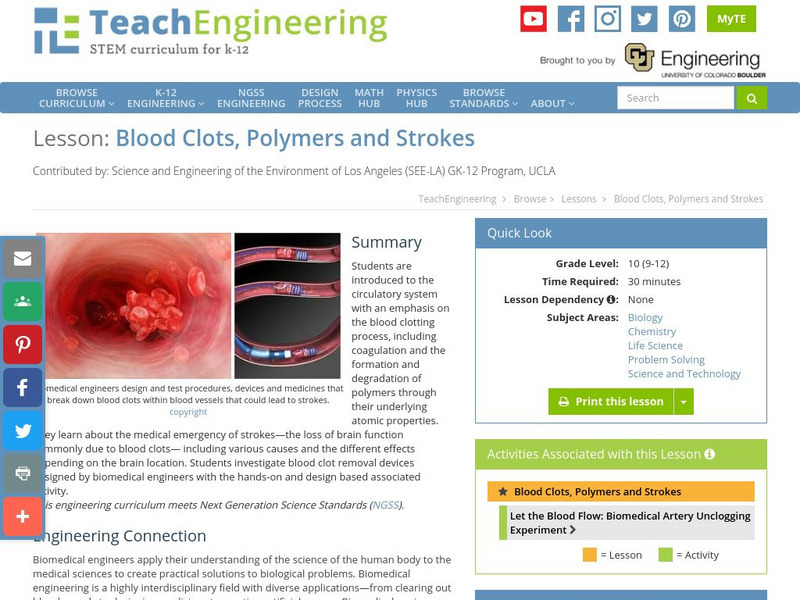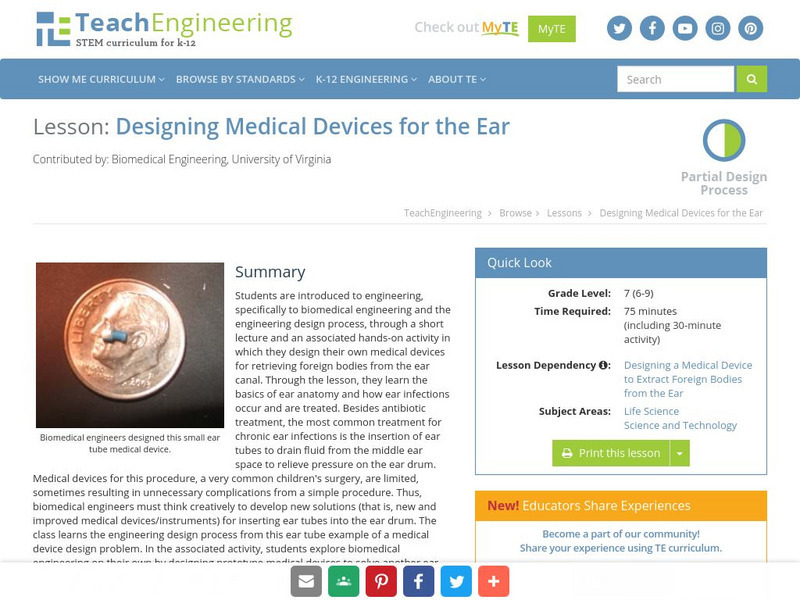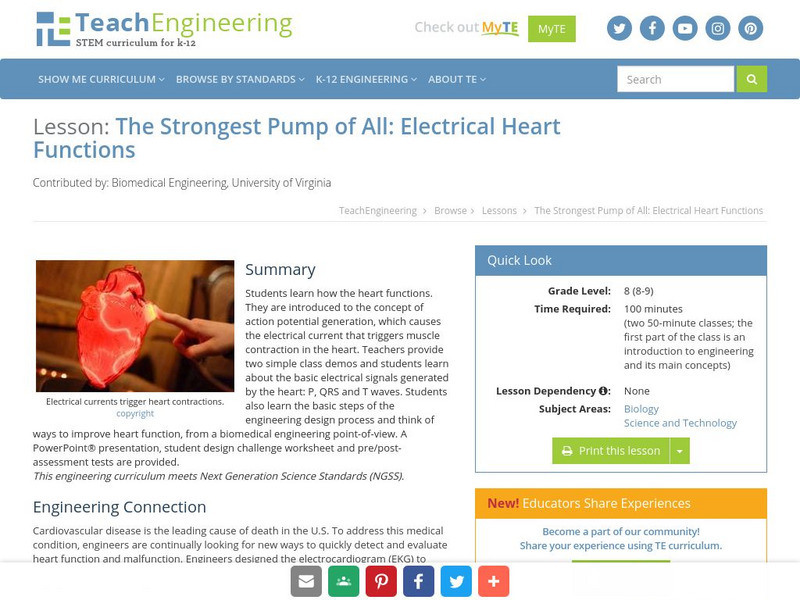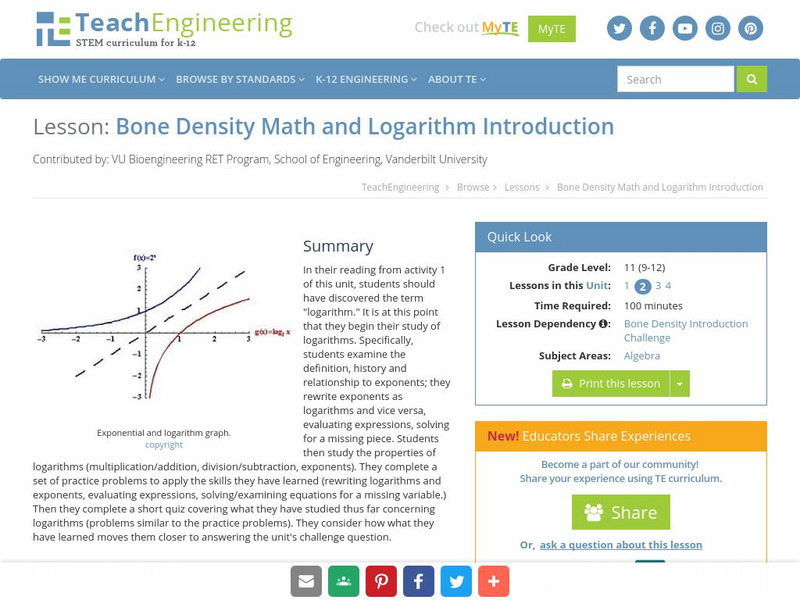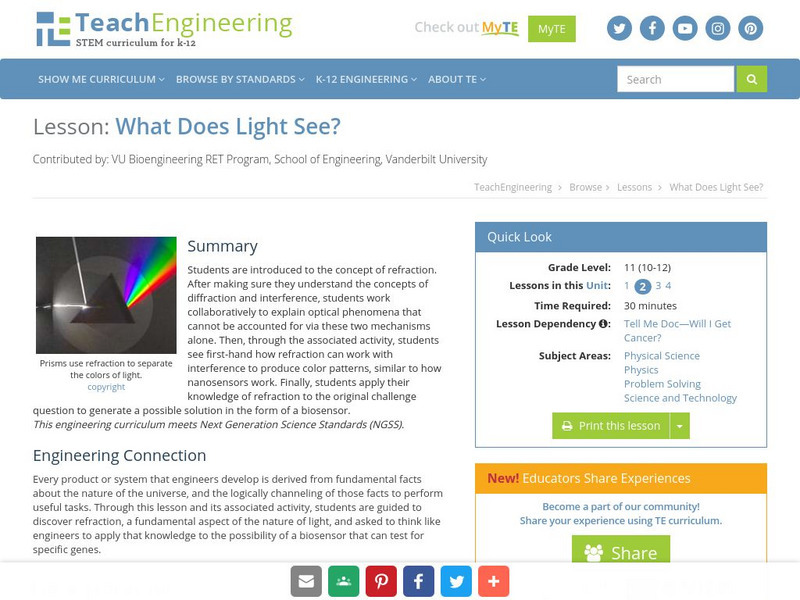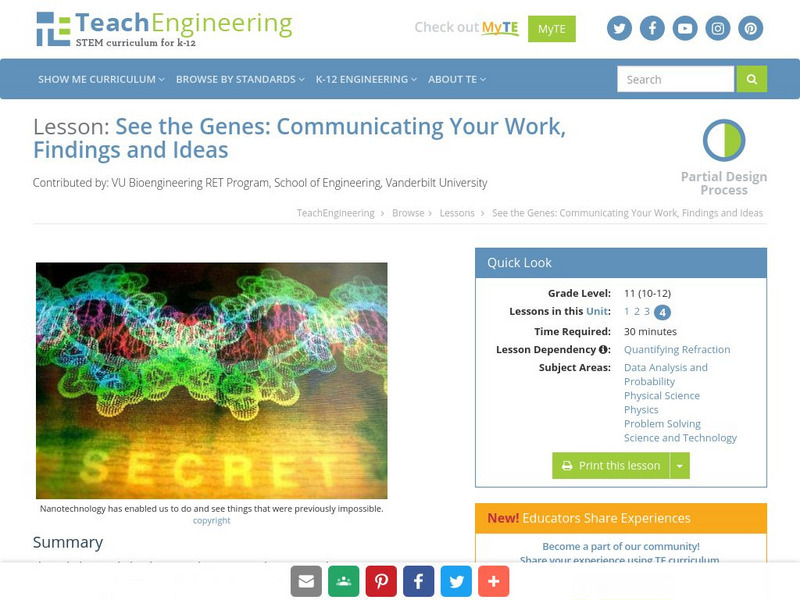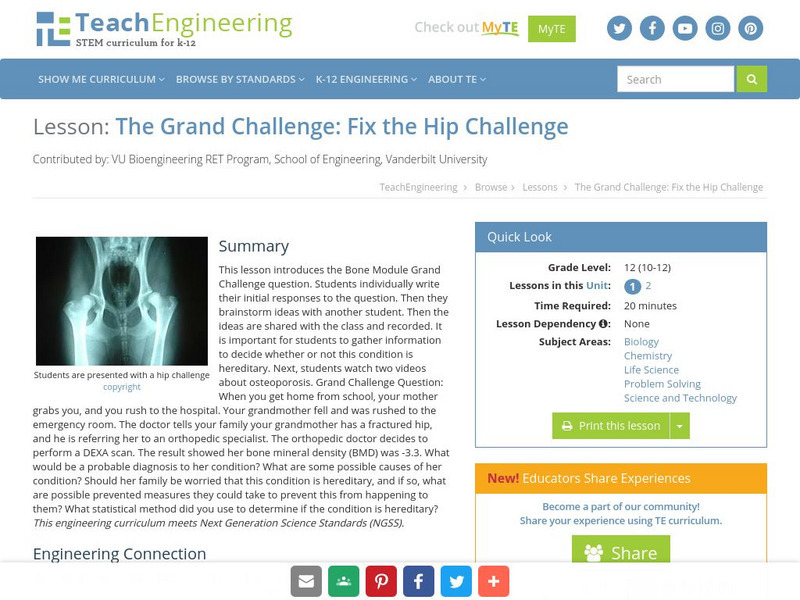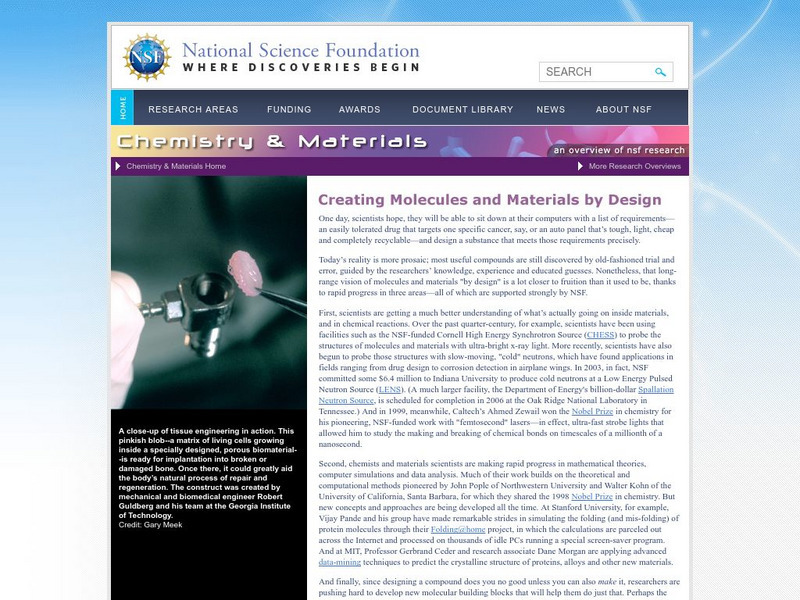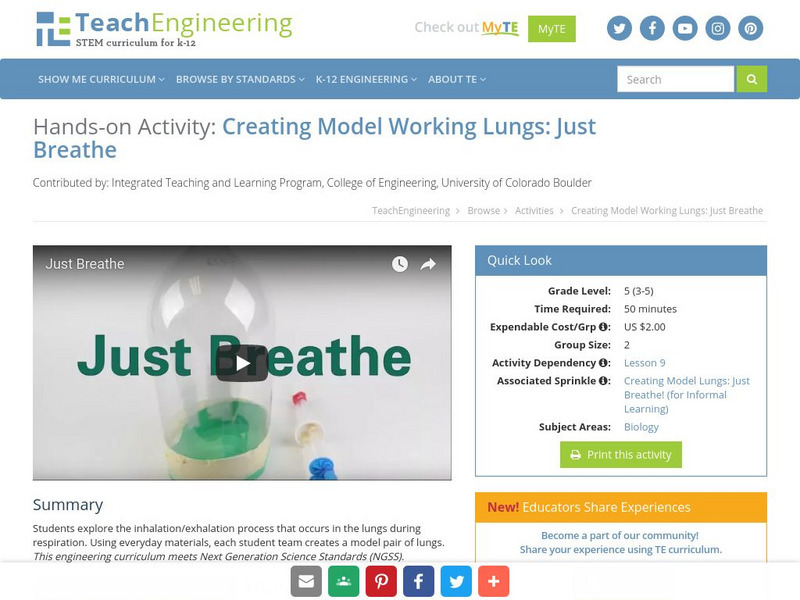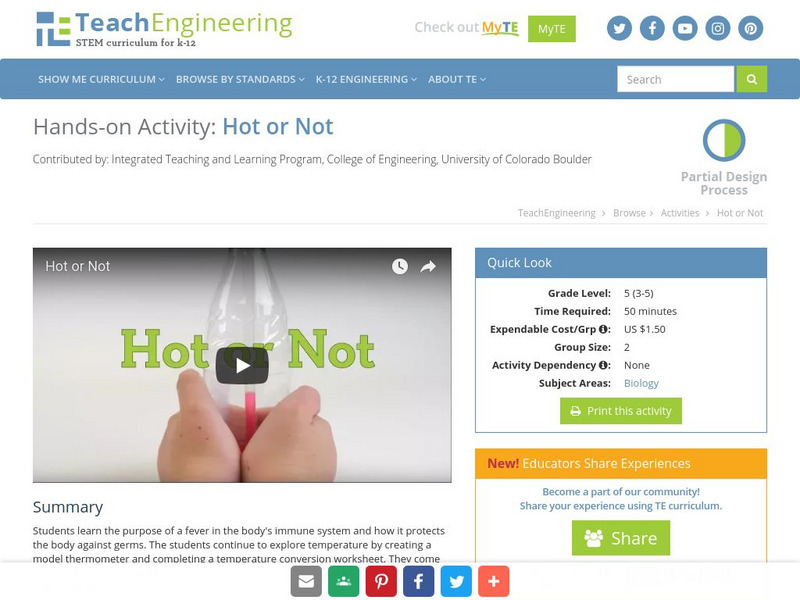TeachEngineering
Teach Engineering: Pharmaceutical Research Design Problem
Through this instructional activity and its associated activity, learners explore the role of biomedical engineers working for pharmaceutical companies. First, students gain background knowledge about what biomedical engineers do, how to...
TeachEngineering
Teach Engineering: Blood Clots, Polymers and Strokes
Students are introduced to the circulatory system with an emphasis on the blood clotting process, including coagulation and the formation and degradation of polymers through their underlying atomic properties. They learn about the...
TeachEngineering
Teach Engineering: Passing the Bug
Students apply concepts of disease transmission to analyze infection data, either provided or created using Bluetooth-enabled Android devices. This data collection may include several cases, such as small static groups (representing...
TeachEngineering
Teach Engineering: Imaging Dna Structure
Students are introduced to the latest imaging methods used to visualize molecular structures and the method of electrophoresis that is used to identify and compare genetic code (DNA). Students should already have basic knowledge of...
TeachEngineering
Teach Engineering: Designing Medical Devices for the Ear
Students are introduced to biomedical engineering and the engineering design process through a short lecture and an activity in which they design their own medical devices for retrieving foreign bodies from the ear canal. They learn...
TeachEngineering
Teach Engineering: The Strongest Pump of All
In this lesson the students will learn how the heart functions. Students will be introduced to the concept of action potential generation. The lesson will explain how action potential generation causes the electrical current that causes...
TeachEngineering
Teach Engineering: Bone Density Math and Logarithm Introduction
This project shows the connection between engineering, science and math by having students learn the equation needed to calculate bone mineral density. Lesson includes an explanation of the equation as well as practice problems and a quiz.
TeachEngineering
Teach Engineering: Tell Me Doc, Will I Get Cancer?
Young scholars are introduced to the challenge called, Tell Me the Odds, discovering a new way to assess a person's risk of breast cancer. Solving this challenge requires knowledge of refraction and the properties of light.
TeachEngineering
Teach Engineering: What Does Light See?
Students are introduced to the concept of refraction. After making sure they understand the concepts of diffraction and interference, students work collaboratively to explain optical phenomena that cannot be accounted for via these two...
TeachEngineering
Teach Engineering: Quantifying Refraction
Students learn the relevant equations for refraction (index of refraction and Snell's law) and how to use them to predict the behavior of light waves in specified scenarios.
TeachEngineering
Teach Engineering: See the Genes
Through this concluding lesson and its associated activity, students experience one valuable and often overlooked skill of successful scientists and engineers- communicating work and ideas. Students create posters depicting their...
TeachEngineering
Teach Engineering: The Grand Challenge: Fix the Hip Challenge
This lesson introduces the Bone Module Grand Challenge question. Students are asked to write their initial responses to the question alone. They will then brainstorm ideas with one other student. Finally, the ideas are shared with the...
TeachEngineering
Teach Engineering: Skeletal System Overview
Young scholars will learn about bone structure, bone development and growth, and bone functions. Later, students will apply this understanding to answer the Challenge Question presented in the "Fix the Hip" lesson plan and use the...
Read Works
Read Works: A New Tail
[Free Registration/Login Required] This passage is about Winter, a dolphin who got caught in a crab trapline and lost his tail, and how they made a prosthetic tail for him so he could swim. A comprehension question set and a vocabulary...
TeachEngineering
Teach Engineering: Making Model Microfluidic Devices Using Jell O
Students create large-scale models of microfluidic devices using a process similar to that of the PDMS and plasma bonding that is used in the creation of lab-on-a-chip devices. They use disposable foam plates, plastic bendable straws and...
National Institutes of Health
National Library of Medicine: Medline Search
Search of National Library of Medicine for all current research articles on a specific topic. Students must enter key words in the search box. Results are abstracts of research articles.
National Science Foundation
National Science Foundation: Chemistry & Materials: Creating Molecules and Materials by Design
Describes the progress being made in materials engineering, so that one day in the not too distant future scientists will easily be able to use a computer to design materials that meet any required properties.
TED Talks
Ted: Ted Ed: Earth's Mass Extinction
Asteroid strikes get all the coverage, but "Medea Hypothesis" author Peter Ward argues that most of Earth's mass extinctions were caused by lowly bacteria. The culprit, a poison called hydrogen sulfide, may have an interesting...
TeachEngineering
Teach Engineering: Walk, Run, Jump!
In this activity, students participate in a series of timed relay races using their skeletal muscles. The compare the movement of skeletal muscle and relate how engineers help astronauts exercise skeletal muscles in space.
TeachEngineering
Teach Engineering: Muscles, Muscles Everywhere
This activity helps students learn about the three different types of muscles and how outer space affects astronauts' muscles. They will discover how important it is for astronauts to get adequate exercise both on Earth and in outer...
TeachEngineering
Teach Engineering: The Beat Goes On
In this activity, students learn about their heart rate and different ways it can be measured. Students construct a simple measurement device using clay and a toothpick, and then use this device to measure their heart rate under...
TeachEngineering
Teach Engineering: Do You Have the Strength?
In this activity, students squeeze a tennis ball to demonstrate the strength of the human heart. Working in teams, they think of ways to keep the heart beating if the natural mechanism were to fail. The goal of this activity is to get...
TeachEngineering
Teach Engineering: Just Breathe
Students explore the inhalation/exhalation process that occurs in the lungs during respiration. Using everyday materials, they create a model pair of lungs.
TeachEngineering
Teach Engineering: Hot or Not
This activity explains what a fever is and how the immune system uses it to try and protect the body against germs. The students then explore temperature further by creating a model of a thermometer and completing a temperature...


